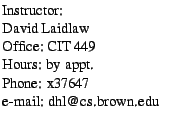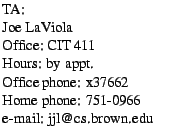


Brown University
Fall 1999
Interactive Scientific Visualization
CS 295-5
Tuesday/Thursday 2:30-4
Lubrano (CIT 477)
Handout #1



In this class we will learn about solving scientific problems using computer graphics and visualization. Students will work in small multi-disciplinary groups to identify scientific problems, propose solutions involving computational modeling and visualization, design and implement the solutions, apply them to the problems, and evaluate their success. Solutions may be, for example, interactive software systems, immersive CAVE applications, or new applications of existing visualization methods.
At the end of CS295-5, students will have experience with:
The course will be organized around ``funding'' and implementing a small interdisciplinary research project. As references, we'll study some funded grant proposals produced by faculty at Brown and elsewhere. We'll start with a program announcement (PA) or request for proposal (RFP), read the proposal, see the reviews that it received, and look at the work that has resulted from the grant. Some of the proposal authors will guest lecture to describe their proposals, work, and philosophy.
Each member of class will create a short proposal on which they are the principal investigator. The proposals should be multi-disciplinary - so each should have 2 or 3 authors, one of them the principal investigator. The class will review the proposals, emulating the NSF review process, and recommend some of the proposals for ``funding.'' The ``funded'' proposals will then be implemented in small groups. Each group will finish with an extended abstract and presentation describing their accomplishments.
During the semester we will also cover several topics motivated by the project topics. Examples might include modeling of medical images, using user studies for evaluation of interfaces or visualization methods, or numerical optimization. Each student will also be responsible for presenting 2-3 papers on topics related to their project.
See the course schedule for more details.
Readings will be copied and handed out or made available via the course Readings/Assignments web page.